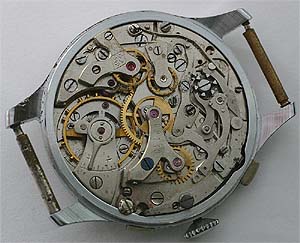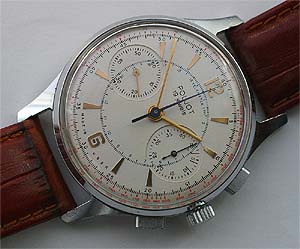Soviet movements (Part 2)
Reviewed by Andrew Babanin
As I told in the Part1 there was a modification of Molnija predecessor Salut. Here it is. A nice functional chronograph with small seconds and 30 min counter. You can notice that this counter is not on the line with small seconds and center hands. I guess sometimes it's quite uneasy to integrate additional function and to leave perfect geometry on the dial. There's only one button which starts, stops and resets chronograph. Nice bluished hands tell about good manners of finishing. To prove it just take a look at the movement - gold plated wheels, polished screws. There are two snap lids covering this movement.
Here there is another one Molnia chronograph, based on 3017 Poljot movement. 3017 is based on Venus 150 Cal.
Here a few pics of another rare pocket chrono, based on Tutima Glashutte.
Here's a pic of more popular wrist chronograph
Also I provide pics of Poljot version of Strela:
One of the first chronos, made by Russians. It's a typical K 43 movement with additional parts. All chrono parts are of the better quality. It tells me, that the base movement produced in Russia but all chrono parts had been bought abroad. If you replace chrono parts - there's an interesting thing - all slots and holes are made not during movement production, but later. So they are not even nickel plated. Another interesting thing - the inscription on the dial. This watch belongs to TMP of Komintern district of Moscow. I've seen a few such watches, belonged to other Moscow districts. I guess they were produced by small workshops. Pay attention to the minute counter subdial: the hand rotates counter clockwise.
Another one is a stop-watch. It's very interesting. Its accuracy till 0.1 sec, because of balance wheel swings with 36,000 bpm.You can notice, that a dial of seconds divided only into 30 seconds. Central minute counter has intermediate positions for every turn of the second hand. Its a real split with two second hands.
Take a look at the movement - 20 jewels, nice finishing, polished parts. There was a special room at the Slava factory where only a few persons had assembled and adjusted these marvellous chronos. I just try to find more info about this stop-watch, but believe me it has not only sporty aims.
 A very rare movement - precision Vostok. This one is gold plated, but mostly its common as nickel plated. All production was under the strict control, only a small part of movements could be called a precise watch. Others (which hadn't passed thru the special tests are known as cheaper Almaz watches. I've read enough about watch tests in USSR - very common with COSC certification. There were some differences - 10 days of testing instead of 15, other temperatures of testing: 00–°, +200–° and +400–°.
A very rare movement - precision Vostok. This one is gold plated, but mostly its common as nickel plated. All production was under the strict control, only a small part of movements could be called a precise watch. Others (which hadn't passed thru the special tests are known as cheaper Almaz watches. I've read enough about watch tests in USSR - very common with COSC certification. There were some differences - 10 days of testing instead of 15, other temperatures of testing: 00–°, +200–° and +400–°.
Unfortunately, I don't have ability now to make pretty nice shots, but still you can notice a microregulator on the balance cock. One of the features of this watch is not central friction. What else? A big balance is fit for the perfect rate.
 This one also is a quite rare movement. There was a fashion for slims in the end of 60s. So every watch plant had designed its own slim. As I told in the part 1 Poljot produced Orbita movement 2209 and thinner 2200, Raketa showed its own 2209 of the same size (22 mm). Later there was a competition. The best was Poljot movement. This one wasn't as reliable as Orbita. Nevertheless it's very interesting movt. Pay attention to the winding system. It's made vice versa. The ratchet and crown wheels are under the dial. Forgive me for absence of the clutch in keyless works :). Look at the wheel bridge. It looks like skeleton. I like this movement, in spite of the fact that many watchmakers hate it for its whimsicality.
This one also is a quite rare movement. There was a fashion for slims in the end of 60s. So every watch plant had designed its own slim. As I told in the part 1 Poljot produced Orbita movement 2209 and thinner 2200, Raketa showed its own 2209 of the same size (22 mm). Later there was a competition. The best was Poljot movement. This one wasn't as reliable as Orbita. Nevertheless it's very interesting movt. Pay attention to the winding system. It's made vice versa. The ratchet and crown wheels are under the dial. Forgive me for absence of the clutch in keyless works :). Look at the wheel bridge. It looks like skeleton. I like this movement, in spite of the fact that many watchmakers hate it for its whimsicality.
What was odd in this movement, what was bad in other slims, in 2409 (see part 1)? There's a parasite wheel. This movement like Orbita and Cosmos were very complex. That's why they were left behind.
 Two more Raketas. An older one and a bit newer. They are just basic movements. I reviewed one interesting movement, based on an older 2609 I.
Two more Raketas. An older one and a bit newer. They are just basic movements. I reviewed one interesting movement, based on an older 2609 I.
I had to repair old Fortis and noticed that it's equal with 2609. It wasn't the same movement - but really very even. Here I just mention, that there were several modifications of an older movement. This one is "A" modification. As to newer one - it came to me from the cheapest Chinese Oreintex for 11 years ago. In Chinese watches I also found quartz Poljot and Luch 1656 calibers. They are different.
 The newer caliber 2609H or 2614H(with calendar) is a work horse. It would have made a concurrency to Poljot 2614H, if Raketa factory wasn't a bankrupt.
The newer caliber 2609H or 2614H(with calendar) is a work horse. It would have made a concurrency to Poljot 2614H, if Raketa factory wasn't a bankrupt.
Here there is a sample of the extremely rare Raketa 3031, based on 33 jewels. It's alarm watch with automatic winding. There's almost no info about this such a pretty watch except it was produced approximatedly 2000 pieces and it cost about 96 roubles - two times more than normal soviet watch of that time - very expensive. The alarm hammer is strike against special spring - gong. Tha autowind module is based on two reverse wheels - bi-directional.
Another one quite rare sample - Chaika 1200. It is the smallest Russian caliber. In was produced not for a long time and there is almost no info about such a tiny watch. Here there are a few pics.
Interesting quartz watch with balance wheel:

 English
English –†—Г—Б—Б–Ї–Є–є
–†—Г—Б—Б–Ї–Є–є























